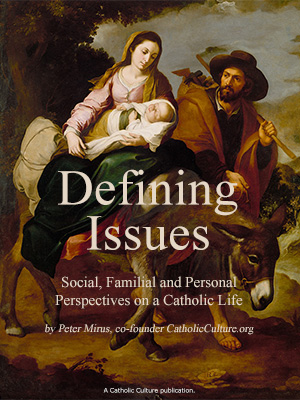A Simple Purpose: Helping Tribunals Handle Their Work Better
The Instruction Dignitas Connubii which we are presenting today is the result of the lengthy endeavor that the Dicasteries of the Holy See here represented embarked on, at the Holy Father's explicit request, in 1996: in addition to the Pontifical Council for Legislative Texts, the Congregation for the Doctrine of the Faith, the Congregation for Divine Worship and the Discipline of the Sacraments, the Supreme Tribunal of the Apostolic Signatura and the Apostolic Tribunal of the Roman Rota.
Reason for this Document
The purpose of the Instruction is very simple: to offer the ministers of justice who work in ecclesiastical tribunals a practical Document, a sort of vademecum that will serve as an easy guide to enable them to handle their work better in canonical processes of matrimonial nullity. Thus, it was desired to repeat the positive experience that the similar Instruction, Provida Mater, met with in 1936.
Both Instructions were published about 20 years after the respective Codes of Canon Law (1917 and 1983), not in order to compare the Codes with another legislative text nor, still less, to abrogate them, but merely to facilitate their consultation and application.
On the one hand, the Instruction presents in a unified manner all that concerns the canonical process of matrimonial nullity, as distinct from the Code of Canon Law in which the relative norms are scattered in the various sections.
On the other hand, it integrates the juridical developments that occurred in the period immediately following the promulgation of the Code: the authentic interpretations of the Pontifical Council for Legislative Texts, the responses of the Supreme Tribunal of the Apostolic Signatura, the jurisprudence of the Apostolic Tribunal of the Roman Rota.
As usually happens with norms that are less important than laws, this Instruction does not only reiterate the text of the canonical code, but also contains interpretations, explanations of what the laws prescribe and further measures concerning procedures for their execution.
With this Document the Holy See intends once again to exercise its universal mission regarding the administration of justice throughout the Church: in this case, concretely in the context of the Latin Church. Far from diminishing the responsibility of diocesan Bishops for the individual tribunals dependent upon them, it seeks with this mission to strengthen and encourage them in a positive way.
As the Holy Father reasserted a few days ago, the diocesan Bishops are "by divine law judges in their communities.... It is on their behalf that the tribunals administer justice. Bishops are therefore called to be personally involved in ensuring the suitability of the members of the tribunals, diocesan or interdiocesan, of which they are the Moderators, and in verifying that the sentences passed conform to right doctrine. Sacred Pastors cannot presume that the activity of their tribunals is merely a 'technical' matter from which they can remain detached, entrusting it entirely to their judicial vicars (cf. CIC, cann. 391, 1419, 1423 § 1)" (Address to the Roman Rota, 29 January 2005, n. 4; L'Osservatore Romano English edition, [ORE], 2 February, p. 3).
The full and dynamic involvement of the particular Churches is in fact crucial if the functioning of tribunals and the training of ministers of justice are to be improved, inconsistencies set right and abuses in proceedings corrected, and if sentences are to conform fully to the Church's legislation and doctrine on marriage.
On this subject, it is also increasingly necessary to activate the synergy of ecclesial communion between the universal Church and the particular Churches, understanding that the Apostolic See's interventions constitute neither an interference nor an intention to relieve any of the competent bodies of responsibility: indeed, their purpose is quite the opposite.
Reason for the canonical process of matrimonial nullity
This Instruction confirms the need to submit the question of the validity or nullity of a marriage of the faithful to a truly judicial trial.
Sometimes, this traditional praxis of the Church is the subject of criticism or reservations, as though an excessive formalism were entailed. Simpler ways to a solution are suggested that would even solve the problem solely in the internal forum, through the so-called "nullity of conscience", in which the Church would do no more than to register the conviction of the spouses themselves as to whether or not their marriage was valid.
Sometimes, it is also hoped that the Church would give up any sort of trial and leave this kind of juridical problem in the hands of courts of civil law.
On the contrary, the Church reaffirms her competence to deal with these causes, for in them is at stake the existence of the marriage of at least one of her faithful, especially if we remember that marriage is one of the seven sacraments instituted by Christ himself and entrusted to the Church. To forgo involvement in this problem would be equivalent, in practice, to obscuring the sacramental holiness of marriage.
This would be even harder to understand in the present circumstances of confusion about the natural identity of marriage and the family in some civil legislation that not only accepts and facilitates divorce but in certain cases even casts doubt on the indispensable feature of heterosexuality in marriage.
Furthermore, neither in the Church nor in civil society can marriage be considered an exclusively private matter whose validity could be judged by the parties themselves with a juridic efficacy that would permit them to contract another union.
Apart from the great unreliability of human judgment on matters of a strong personal involvement where there can obviously be discrepancies between the parties themselves, it is necessary above all to understand that the conjugal bond, the true foundation of a family, does not only concern the spouses but also any children who may be born to them, and the whole of society, both ecclesial and civil.
Marriage, therefore, in conformity with a conviction rooted in the civilizations of all the ages, is a public union. Hence, those who contract it cannot declare its nullity themselves.
What is necessary instead is a true ascertainment of the objective truth concerning the validity or invalidity of the union.
This commitment to seeking the truth must satisfy two fundamental conditions: it must permit the defense and discussion of the arguments both for and against nullity, as well as the gathering of evidence that proves the one or the other. It must also assign the task of judgment to an impartial third party.
These two prerequisites are—essential to judicial proceedings, a juridic institution which, moreover, the Church herself has largely contributed to shaping throughout history.
In the case of the processes of matrimonial nullity, a specific role has been introduced that enables those characteristics to be maintained when both parties are in agreement in requesting the declaration of nullity: in each case it is the task of the defender of the bond to contribute all that can be deduced in favor of the existing validity of the marital bond.
Everyone knows human fallibility can lead to a practical decision in which there is no true justice, or in which it may be delayed: Of course, it is not easy to judge when these situations actually do occur, so it is essential to be cautious in providing information on proceedings, avoiding the superficiality of a tabloid scandal with no proper basis.
On the other hand, it would be absurd to denigrate in general a means valid in itself such as an ecclesiastical tribunal, merely because it may not have functioned well in a few cases.
In this regard, the Church intends to take the only wise path: to persevere in her intention to improve the seriousness and rapidity of proceedings, facilitating access to them for all concerned, providing equal opportunities and rendering the decisions of all tribunals increasingly uniform.
Basic question: the good of marriage and of the family
Through the efforts by personnel and the means that she designates to this pastoral field, the Church desires to make a positive contribution to achieving an important objective which is central to John Paul II's Pontificate: the good of marriage and the family.
"The future of humanity passes by way of the family!" (Post-Synodal Apostolic Exhortation Familiaris Consortio, 22 November 1981, n. 86): this heartfelt exclamation of the Pope shows the urgent need for the commitment of the Church, of Christians and of a multitude of people of good will to protect and promote marriage and the family in the contemporary historical context.
The pressures of hedonism and selfishness that subordinate everything to their own satisfaction is a tremendous pastoral challenge in our day. What stands in danger of passing unperceived is the goodness and beauty of the matrimonial and family institution in its genuine essence as a profoundly personal reality.
People forget that it is necessary to fight to stay faithful to a commitment of love and justice, which by its nature embraces the whole of life: the reciprocal gift of husband and wife for the purpose of creating a family open to life and that death alone can dissolve (cf. can. 1141).
In the context of a divorce mentality, canonical proceedings of annulment can also easily be misunderstood as no more than a means to obtain a divorce with apparent Church approval. The difference between nullity and divorce would be merely nominal. By skilful manipulation of the causes of nullity, every failed marriage would be annulled.
The Roman Pontiffs, especially in their annual Address to the Roman Rota, have often demonstrated the true meaning of matrimonial nullity which is inseparable from the search for the truth, since the declaration of nullity is in no way the dissolution of an existing bond but merely an observation, in the name of the Church, of the inexistence of a true marriage from the start.
Indeed, wherever possible, the Church encourages the convalidation of marriages that are null. John Paul II explained it as follows: "The spouses themselves must be the first to realize that only in the loyal quest for the truth can they find their true good, without excluding a priori the possible convalidation of a union that, although it is not yet a sacramental marriage, contains elements of good, for themselves and their children, that should be carefully evaluated in conscience before reaching a different decision" (Address to the Roman Rota, 28 January 2002, n. 6; ORE, 6 February, p. 6).
In short, it is necessary to rediscover the dignity of marriage in the dimensions of both human nature and salvation in Christ.
As an indispensable good for persons and societies, the riches of marriage and the family, which in Christ are transformed into a real process of sanctification and of an apostolate, is what this Instruction intends to promote, in accordance with its specific juridic dimension.
This item 6382 digitally provided courtesy of CatholicCulture.org






